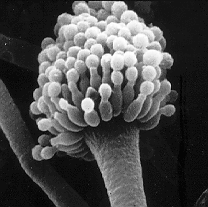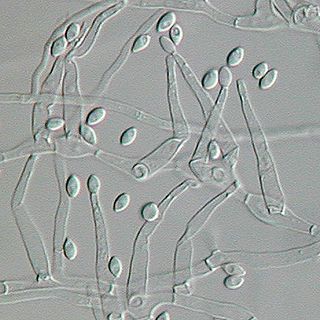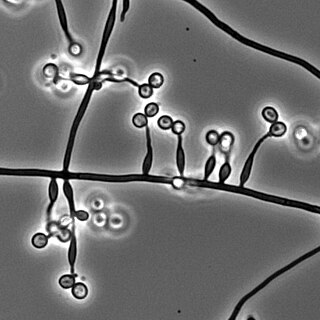A nematicide is a type of chemical pesticide used to kill plant-parasitic nematodes. Nematicides have tended to be broad-spectrum toxicants possessing high volatility or other properties promoting migration through the soil. Aldicarb (Temik), a carbamate insecticide marketed by Bayer CropScience, is an example of a commonly used commercial nematicide. It is important in potato production, where it has been used for control of soil-borne nematodes. Aldicarb is a cholinesterase inhibitor, which prevents the breakdown of acetylcholine in the synapse. In case of severe poisoning, the victim dies of respiratory failure. It is no longer authorised for use in the EU and, in August 2010, Bayer CropScience announced that it planned to discontinue aldicarb by 2014. Human health safety and environmental concerns have resulted in the widespread deregistration of several other agronomically important nematicides. Prior to 1985, the persistent halocarbon DBCP was a widely used nematicide and soil fumigant. However, it was banned from use after being linked to sterility among male workers; the Dow Chemical company was subsequently found liable for more than $600 million in damages.

The Eurotiales are an order of sac fungi, also known as the green and blue molds. It was circumscribed in 1980.

Paecilomyces is a genus of fungi. A number of species in this genus are plant pathogens.
Paecilomyces fulvus is a plant pathogen that causes Byssochlamys rot on strawberries.

Farinomalein is a natural maleimide with formula C10H13NO4 - was first isolated from the entomopathogenic fungus Isaria farinosa (Paecilomyces farinosus) - source H599 (Japan).
Byssochlamys is a former genus of fungi in the Trichocomaceae family, containing teleomorph forms of Paecilomyces. Several species of the genus Byssochlamys were well known to be associated with food spoilage, especially acidic heat-processed foods. A health concern was the production the mycotoxin patulin in fruit juices, as well as byssochlamic acid and mycophenolic acid.

Purpureocillium is a fungal genus in the Ophiocordycipitaceae family. The genus now contains at least 5 species with the type species Purpureocillium lilacinum, a common soil mold. It has been isolated from a wide range of habitats, including cultivated and uncultivated soils, forests, grassland, deserts, estuarine sediments and sewage sludge, and insects. It has also been found in nematode eggs, and occasionally from females of root-knot and cyst nematodes. In addition, it has frequently been detected in the rhizosphere of many crops. The species can grow at a wide range of temperatures – from 8 to 38 °C for a few isolates, with optimal growth in the range 26 to 30 °C. It also has a wide pH tolerance and can grow on a variety of substrates. P. lilacinum has shown promising results for use as a biocontrol agent to control the growth of destructive root-knot nematodes.

Purpureocillium lilacinum is a species of filamentous fungus in the family Ophiocordycipitaceae. It has been isolated from a wide range of habitats, including cultivated and uncultivated soils, forests, grassland, deserts, estuarine sediments and sewage sludge, and insects. It has also been found in nematode eggs, and occasionally from females of root-knot and cyst nematodes. In addition, it has frequently been detected in the rhizosphere of many crops. The species can grow at a wide range of temperatures – from 8 to 38 °C for a few isolates, with optimal growth in the range 26 to 30 °C. It also has a wide pH tolerance and can grow on a variety of substrates. P. lilacinum has shown promising results for use as a biocontrol agent to control the growth of destructive root-knot nematodes.
Rhodotorulapepsin is an enzyme. This enzyme catalyses the following chemical reaction

Paecilomyces variotii, also known by the name Byssochlamys spectabilis for the sexual state, is a common environmental mold from the Phylum Ascomycota. It is widespread in the environment and can be found in composts, soils and wood, as well es a common environmental contaminant in indoor air and carpet dust. Ascospores of the sexual state of P. variotii are strongly heat-resistant. As such the fungus is a common contaminant of heat-treated foods and juices. Paecilomyces variotii has been associated with a number of infective diseases of humans and animals.
Paecilomyces hepiali is an entomophagous fungus. Based on 18S rDNA sequencing, this species is distinct from Ophiocordyceps sinensis. Samsoniella hepiali is defined by NCBI as a homotypic synonym of P. hepiali. Further work on the classification of this species was described in 2020.
Isaria fumosorosea is an entomopathogenic fungus, formerly known as Paecilomyces fumosoroseus. It shows promise as a biological pesticide with an extensive host range.
Paecilomyces marquandii is a soil-borne filamentous fungus distributed throughout temperate to tropical latitudes worldwide including forest, grassland, sewage sludge and strongly metal polluted area characterized by high tolerance in heavy metals. Simultaneous toxic action of zinc and alachlor result an increase in uptake of metal in this fungus but disrupts the cell membrane. Paecilomyces marquandii is known to parasitize the mushroom, Cuphophyllus virgineus, in the family, Hygrophoraceae. Paecilomyces marquandii is categorised as a biosafety risk group 1 in Canada and is not thought to be a significant pathogen of humans or animals.
Fictibacillus is a genus of bacteria from the family of Bacillaceae.

Mariannaea elegans an anamorphic fungus. It is mainly found on rotting wood and soil. M. elegans is not pathogenic to humans, animals, or plants.

Metarhizium granulomatis is a fungus in the family Clavicipitaceae associated with systemic mycosis in veiled chameleons. The genus Metarhizium is known to infect arthropods, and collectively are referred to green-spored asexual pathogenic fungi. This species grows near the roots of plants and has been reported as an agent of disease in captive veiled chameleons. The etymology of the species epithet, "granulomatis" refers to the ability of the fungus to cause granulomatous disease in susceptible reptiles.
Paecilomyces niveus is a species of fungus in the genus Paecilomyces in the order of Eurotiales.
Paecilomyces lagunculariae is a species of fungus in the genus Paecilomyces in the order of Eurotiales.
Paecilomyces formosus is a species of fungus in the genus Paecilomyces in the order of Eurotiales.
Paecilomyces paravariotii is a species of fungus in the genus Paecilomyces in the order of Eurotiales, closely related to Paecilomyces variotii.






